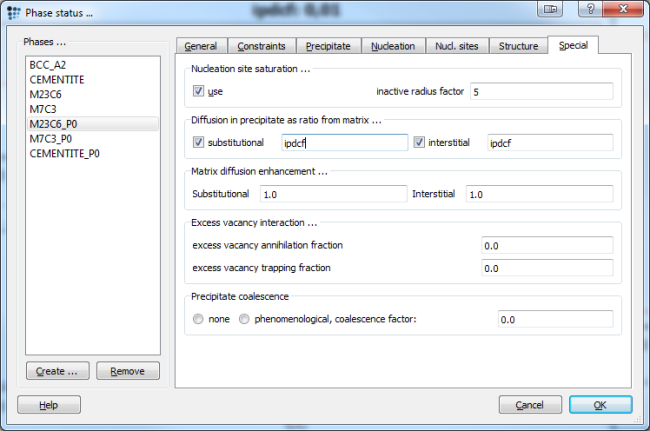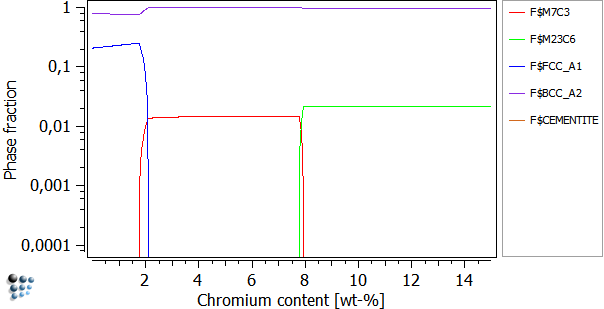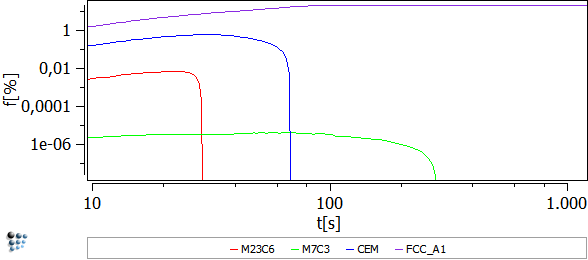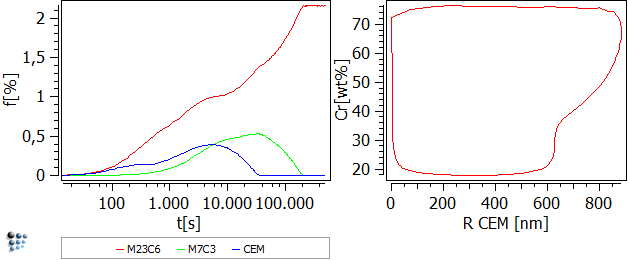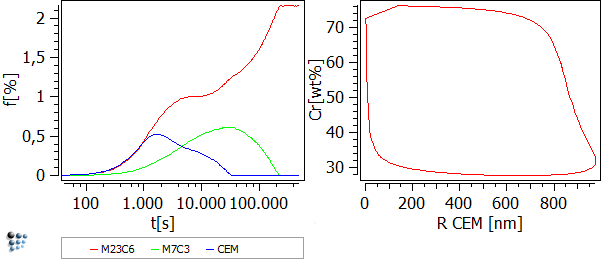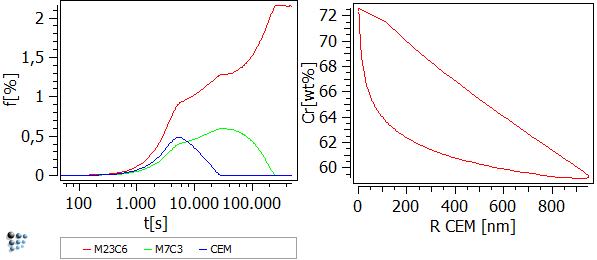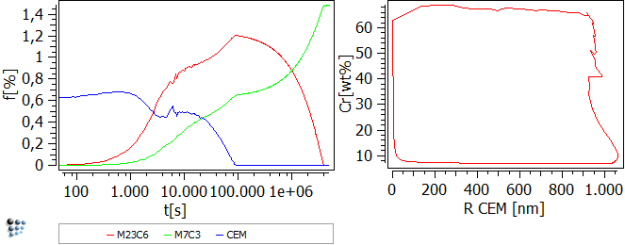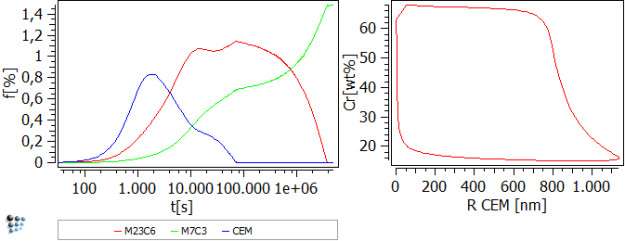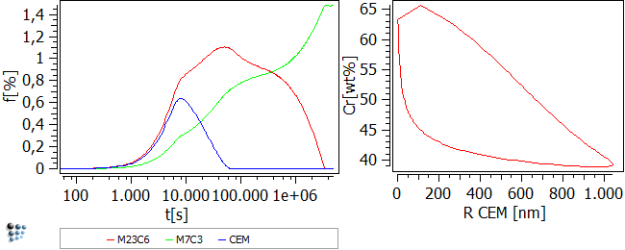Table of Contents
Example P5: Concurrent growth of precipitates in Fe-12%Cr-0.1%C, part 2: Evaluation of inner particle diffusion coefficient
Compatibility
MatCalc version: 5.44.1010
Database: mc_sample_fe.tdb, mc_sample_fe.ddb
Author: Georg Stechauner
Created: 2012-02-16
Revisions:
Objectives
Part two of this example elaborates the influence of variations of the inner particle diffusion coefficient factor (ipdcf) on the evolution of phase fraction and chromium content of the precipitates as a function of radius.
Values for ipdcf range from 1, which represents equal diffusion rates both inside and outside of the precipitate, to 0.01, which is the default value and correlates with real observations, where diffusion inside the precipitate is much slower than outside.
Related documents
- A. Schneider, G. Inden, Simulation of the kinetics of precipitation reactions in ferritic steels, Acta Materialia 53 (2005) 519-531
Complementary files
Click here to view the script for this example.
Main document
Understanding the script
The script contains two pieces of interest, which are responsible for the variation in ipdcf without having to copy&paste the same portion of code over and over again.
We'll start of by discussing the for loop:
for(i;0..2) $ Change ipdcf to values: 1, 0.1, 0.01 set-variable-value ipdcf 10^(-i) $ Create an ipdcf string (copy ipdcf as float variable to ipdcfstring) format-variable-string ipdcfstring %.2f ipdcf set-variable-value incr i*30 ... remaining code ... endfor
As the values of i change with each iteration from 0 to 2, the values of ipdcf change from 100 (→ 1), 10^-1 (→0.1) to 10-2 (→0.01).
When having a look at the script, you'll notice that the ipdcf is set anew with each iteration, thus every iteration uses different values. Note: It is necessary to delete the size classes prior to filling them again, as this would result in an error.
The next code portion of interest is the format-variable-string used in the script. By using the aforementioned command, you can save a numerical value as ipdcf is, to a string value, which can be used in titles. The parameter %.2f reads as:
- %f → save as a float variable.
- .2 → No reserved space in front of the number, two digits behind the comma.
- %.2f → Save the numerical value ipdcf to the string ipdcfstring with two digits after the comma.
Note: Using %d as we did in other examples would result in the values 1, 0, 0 as the parameter d converts only integer, full numbers!
Manually change the ipdcf
It is highly recommended to use the script for this second part, as many windows have to be created. Apart from that, use the same settings as in part one and simply change the 'Diffusion in precipitate as ration from matrix' values for both substitutional and interstitial from 1 to 0.1 and 0.01. The value which is set to 'ipdcf' in the figure below can be found in the Phase status dialog at the Special tab.
After changing the factor, be sure to perform one of the following steps:
- Either lock the series of the plotted results, set up new output windows, rename and change their appearance correspondingly, and plot the data anew. This approach was used in the script.
- Duplicate and lock, and simply perform the precipitation kinetic simulation. Keep in mind that this will probably lead to confusing and overloaded plots.
- Simply perform the precipitation kinetic simulation. Keep in mind that this will overwrite your actual results, not enabling you to compare the results.
Determining stable phases
As a pre-simulation we can perform a stepped calculation varying the chromium content in order to find the stable phases as a function of chromium. Variation of temperature is not of interest, as all the precipitation simulations are performed isothermally at 780C. When plotting the phase fractions over temperature, the following figure can be established:
For high chromium content both ferrite and M23C6 are stable. Upon decreasing the chromium amount, a transition area is reached at about 8% Cr where M7C3 becomes the stable phase. This region lasts until the chromium content reaches 2%, where all precipitates become unstable and only the matrix phases BCC_A2 (ferrite) and FCC_A1 (austenite) are stable. As MatCalc cannot consider two matrix phases during a precipitation calculation at once, the problem was dodged by assuming FCC_A1 to be a precipitate. Creating the FCC_A1_p0 exactly as the other precipitates and setting its nuclei starting size to 1nm as well, results in the figure found below. The phase fraction of 20% is very close to the results of the equilibrium calculation. Further it is shown that the other precipitates grow at first, and dissolve later on as the carbon diffuses to the FCC_A1 precipitate.
Influence of IPDCF on the 12%Cr-0.1%C system
Important note …
The following table shows figures including the results of a variation of the ipdcf. The left figure shows the phase fraction of the precipitates, while the right one shows the chromium content of 'cementite' as a function of its radius. For a high ipdcf, the precipitates' chemical composition changes drastically compared to the results gained at a low ipdcf.
The phase fraction figure show a time shift from early values to later ones as the ipdcf decreases. This happens due to the slower movement of atoms within the precipitate. For an ipdcf of 1 it is easily possible to quickly build the thermodynamically most stable state. This process takes more and more time as the ipdcf decreases to 0.01.
Influence of IPDCF on the 7%Cr-0.1%C system
A similar survey was performed on a different alloy containing less chromium. It can be seen from the phase fraction over chromium content figure above, that M7C3 is expected to be the stable phase compared to M23C7 before.
An ipdcf of 1.0 shows to be to high for this composition, as the radius and phase fraction of cementite is too high due to amazingly fast diffusion speeds. Upon slowing the diffusion down by decreasing the ipdcf, the phase fraction figures resemble the results from above. A time shift can be seen as well.
Comparison to results from DICTRA
Both sections above have shown to reproduce the values of Schneider and Inden very good. However, MatCalc has to vary the ipdcf in order to achieve the exact same result, as the simulation background of both programs are completely different.
